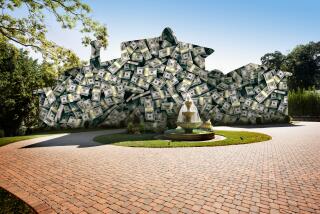Study Finds Property in State Undervalued by Half : Finances: Proposition 13 has caused a loss of $13 billion a year in taxes, report says. It recommends ending measure’s protection for businesses.
- Share via
SACRAMENTO — Proposition 13 has kept property tax assessments for homes, businesses and vacant land in California at about half of true market value, preventing cities and counties from collecting an estimated $13 billion a year in taxes, an extensive study indicates.
But the UC Davis study concluded that there is little chance politicians will loosen the restrictions of the popular tax measure--at least as it affects homeowners--because those who have benefited the most are lower-income residents and the “politically active elderly.”
The $80,000 study, paid for jointly by the UC system and the Legislature, took two years to complete and yields what some experts say is the most comprehensive picture of the effects of Proposition 13.
Supporters of Proposition 13 said the study confirms what they’ve been saying all along: The historic tax-cutting measure is a “people-based” formula that protects homeowners on fixed incomes and puts government on a crash diet.
“They are validating the obvious,” said Joel Fox, president of the Howard Jarvis Taxpayers Assn. “Proposition 13 was designed to protect people from losing their property and from keeping taxes from running out of sight. . . . I say Proposition 13 works.”
Yet the authors of the study say their results also show that Proposition 13 has codified deep inequities on county tax rolls. They said one way to change the system is to allow for full-market assessments on businesses alone--a move they estimated would be worth $3.3 billion to $8.6 billion extra a year to local governments.
Approved in 1978 by voters outraged by fast-rising property taxes, Proposition 13 limits property taxes to 1% of what a person pays to buy a home, business or vacant lot. Once that value has been established, it can only be increased 2% a year, a rate that until recently has lagged far behind the rate of Southern California real estate price inflation.
To study the effects of Proposition 13, researchers compared property tax assessments to the 1990-91 sales prices for buildings and land in 15 counties. The analysis included all 78,600 property transactions in Los Angeles County during that period.
Based on those comparisons, researchers concluded that:
* The assessed values on the tax rolls under Proposition 13 reflect only 55% of what all of California’s homes, businesses and vacant land is worth on the real estate market.
* In urban areas such as Los Angeles, Proposition 13 has created a “pattern of disparity” that allows people who bought their homes in 1975 to pay only one-fifth the property taxes that those who bought in 1991 must pay. In rural areas, the disparity is less, with the 1975 homeowner paying one-third the tax of the 1991 home buyer.
* The biggest losers, if assessments were raised to reflect market values, would be low-income and elderly residents, who enjoy the biggest breaks under Proposition 13 because many bought their homes in 1975 or before. The study found that 82% of the elderly homeowners in Los Angeles County have not moved since Proposition 13 rolled back their rates to 1975 levels.
Raising the assessments across California would increase tax rolls by 80% and net another $13 billion a year for local governments, estimated Steven M. Sheffrin, a UC Davis economics professor and one of the researchers on the study.
But the study suggests a more politically palatable solution would be the so-called split roll that leaves homeowner assessments alone but uses current market values to assess taxes on businesses. The idea was raised two years ago in the Legislature but did not survive.
The study, scheduled to be discussed at a Capitol briefing today, also says another way to overcome the disparities under Proposition 13 would be to change the rate of inflationary increases from 2% to 4%. The move would raise $100 million a year and close the gap between assessments and actual property values more rapidly during times of low inflation, it says.
More to Read
Get the L.A. Times Politics newsletter
Deeply reported insights into legislation, politics and policy from Sacramento, Washington and beyond. In your inbox twice per week.
You may occasionally receive promotional content from the Los Angeles Times.










